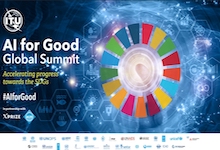AI for outbreaks, emergency response, and risk reduction
18 May 2018 02:00h
Event report
Can artificial intelligence (AI) help predict the spread of diseases? Can machine learning help respondents to better allocate resources in emergencies? These questions were raised by the moderator, Mr Dominic Haazen (Lead Health Policy Specialist, World Bank) to introduce this session, which addressed the potential of AI in the context of epidemics and emergency response.
Mr Ingmar Weber (Research Director for Social Computing, Qatar Computing Research Institute) explored the potential of social media to provide targeted advertising for public health campaigns. Whereas social media is currently predominantly used by public health agencies to broadcast messages, often ‘preaching to the choir’, there is potential to adapt messages to different groups, for example based on age, gender, marital status, location, education level, or interests. While bearing in mind privacy concerns, this allows for the distribution of the right message to the right person at the right time in a very cost-effective way.
Ms Jeanine Vos (Head of SDG Accelerator, GSMA) highlighted the potential of mobile big data to accelerate impact in the context of the sustainable development goals (SDGs), as it can create powerful insights about the location and movement of populations. For example, mobile data could detect the movement of internally displaced persons after an earthquake or the spread of a disease, especially when combined with other sources of data. GSMA’s Big Data for Social Good project explores these opportunities and places them in a consistent framework of best practices.
Ms Clara Palau Montava (Technology Team Lead, UNICEF) presented some of the work of UNICEF’s innovation unit. For example, responding to the 2015 Ebola crisis, it launched an open source messaging platform and worked with mobile operators to detect patterns of movement, extrapolating the spread of the epidemic. In the context of the Zika crisis, the agency combined various data sources, such as mosquito prevalence, poverty, and weather data, to estimate the disease’s dynamics. Montava emphasised that there is a continued need for scientific studies to better understand the bias behind these methods, especially if they are to be combined with machine learning. In addition, innovation in emergency response requires collaboration among organisations, and cannot be done by one agency alone.
Ms Anita Shah (Managing Director of the Kenya office of Kimetrica) presented the Method for Extremely Rapid Observation for Nutritional Status (MERON), aimed to detect malnutrition in children based on facial recognition technologies during humanitarian emergencies. Traditional methods to measure the nutritional status of children in emergency settings are plagued with a number of challenges, such as the skills needed by the researchers, the bulky equipment that needs to be transported, and the degree of physical contact between the researcher and the child. The method can assist in timely identifying the children who are in need of nutrition support. The project is intended to scale up and be tested in different countries and emergency contexts.
Mr Marcel Salathé (Professor & Head of the Digital Epidemiology lab, École Polytechnique Fédérale de Lausanne (EPFL)) explained how health trends could be tracked using crowd-sourced social media data combined with machine learning. EPFL’s ‘Crowdbreaks’ monitors patterns in diseases in real-time across countries by collecting tweets with keywords that could be relevant to specific health issues. The algorithm is continuously updated with newly labelled tweets and feedback from users. As the application of AI to such projects often involves many actors, Salathé emphasised the need to harmonise the diverse incentives of different entities, adding that the failure of some projects is not due to a lack of ‘good’ incentives, but rather, due to their misalignment.
Mr Jochen Moninger (Head of Innovation, Welthungerhilfe) focused on the potential of detecting child malnutrition using AI. He pointed out that nutrition during a child’s first five years is crucial for its development, and while there is enough food in the world, it is not well-distributed; ‘we don’t know where to bring it’. Welthungerhilfe’s tool is developed to identify malnutrition through a mobile app that uses augmented reality in combination with AI, which can calculate someone’s weight and height through a 3D scan. This allows for rapid response to areas where malnutrition is prevalent, as it is of vital importance that action is undertaken swiftly due to the negative impact of children’s sustained malnutrition on their further lives.
Related topics
Related event

